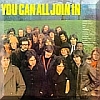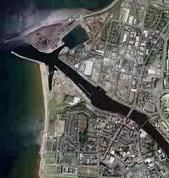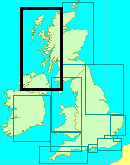You are viewing the expanded version of this Harbour,
for faster browsing
use the regular version here
Ayr Harbour
Courtesy Flag
Flag, Red EnsignWaypoint
Harbour 55:28'N 004:38'WCharts
Admiralty 1866Rules & Regulations
Commercial Port, Shipping has priorityHazards
St Nicholas Rocks just SW of the Entrance, see text. Not viable in strong onshore conditions.Tidal Data Times & Range
+0050 Dover, MHWS 3.0m, MHWN 2.6m, MLWN 1.1m, MLWS 0.5mThis site is designed for slower, roaming broadband connections, like you would get at sea, so it needs JavaScript enabled to expand the text.
General Description
Contacts
Harbour Master VHF #14 or tel 01292 281687
Ayr, is a fair sized town and commercial port with very limited facilities for visiting yachts or motorboats, but decent town centre shopping for the crew not far away.
Entry is simple enough, but the harbour is best avoided in strong onshore winds. In these cases shelter may be found at Lamlash Harbour on the east side of Arran.
There are no dedicated facilities for visiting yachties, the local yacht club used to be the people to contact but they have withdrawn from this and left it up to the harbour authorities (ABP) who do not recommend themselves.
Approach
Approach to this harbour is best made from a long distance off....
.... rather than hugging the coast from the North or South. Various shallow patches and rocky outcrops mean that a good offing must be maintained. These are best seen on the chart supplied.
To the WNW of the harbour lay the Saltpan Patches with minimum depths of 3.8 m, which are likely to result in rough seas during onshore conditions. Just to the South West of the harbour entrance lays St. Nicholas Rock, drying 0.8m, and this is best avoided by staying to seaward of the green conical Outer St. Nicholas buoy (Fl.G.2s).
Before attempting entry call the harbour master on VHF channel 14 (telephone 01292 281687), to find out about any shipping movements. This is an ABP owned harbour.
Traffic signals are displayed from a mast on the edge of the North Quay within the harbour.. two red lights red lights, mean that the harbour is closed.
Night-time entry should be simple enough, with leading lights within the harbour (best seen on the chart) lining up on 098° T
A quick glance at the photo gallery will show what conditions in the entrance are like during an onshore blow, when Ayr is best avoided altogether...
Berthing, Mooring & Anchoring
Upon entering the harbour between the North breakwater and the South pier, the main River should be followed.
On your port side will be the entrance to Griffin commercial docks, and on your starboard side will be the entrance to what used to be the Fish Docks.
Your own research may have lead you to believe that there are visitors berths available on the local yacht club pontoon which are past the North Quay on the port side. They have told us that they do not have space or facilities for visitors and that requests for a visitors mooring should be made to the Harbour Master.
The Harbour Master advises that, apart from the yacht club moorings, the rest of the harbour is commercial and the type of bulk cargoes they handle (coal, fertilizers, lime etc) do not make themselves comfortable neighbours for yachts. They say they wouldn't turn anyone away who needed to stop but suggest that Troon (5 miles north) is a far better option
Don't be tempted to push any further up river than this pontoon, it shallows out rapidly and there are also the stumps of an old bridge structure. The photos in the gallery show all of this very clearly.
Facilities
Not a lot in the way of facilities for the boat, and there are no toilet or shower facilities.
Water will have to be brought by jerry can, as will diesel or petrol which can be obtained locally. Calor gas can also be had locally.
Trailer Sailers may notice on the chart there is a slipway shown within the harbour, apparently this is not safe to use.
The town can offer a good supply of shops, banks and post office. Ayr has always been a hub for shopping in South Scotland with the first department store, Hourstons, opening in 1896. Retailers such as Marks & Spencer's, Debenhams, H&M, etc will be found. There are two main in town shopping centres, the Kyle center and the newer Ayr Central Shopping Center.
Transport wise the town is very well served, with railway links to Glasgow Central, Stranraer, Girvan, Kilmarnock, and Newcastle.
The town also has air links to European cities from Glasgow Prestwick International Airport located just two miles from Ayr. Ayr is also only 35 miles away from Glasgow Airport which operates further international destinations to Europe, America and the Middle East.
The local and long haul bus and coach services running from Ayr complete the picture.
History
Ayr is a town and port situated on the Firth of Clyde, in south-west Scotland. With a population of around 46,000, Ayr is the largest settlement in Ayrshire, of which it is the county town, and has held royal burgh status since 1205. Ayr is the administrative centre of the South Ayrshire council area, which is the unitary local authority.
To the north of Ayr is the adjoining town of Prestwick, famous for its golf and its aviation industry as home of Glasgow Prestwick International Airport. Other neighbouring settlements include Alloway, known for its associations with the poet Robert Burns.
In 2002, Ayr was one of four Scottish towns competing for city status to mark Queen Elizabeth II's Golden Jubilee, losing out to Stirling.
Some History
In 1197, a castle was built by the River Ayr. Shortly afterwards, in 1205, King William the Lion created a burgh at Ayr. On April 26, 1315, the first Parliament of Scotland was held in Ayr by Robert The Bruce at St.John's Tower by the sea. It was once known as 'Inverair/Inverayr', and this usage is still retained in the Scottish Gaelic form of the name Inbhir Àir.
In the 13th century, friars came to Ayr. Friars were like monks, but instead of withdrawing from the world, they went out to preach. According to legend, at the end of the 13th century, the English invited some prominent Scots to a meeting at Ayr, but they then captured and hanged them. In revenge, William Wallace set fire to some barns where English soldiers were staying and burned them to death.
Nevertheless from 1301 to 1312, Ayr was in English hands.
During the 14th century, Ayr flourished. A new settlement grew up across the River Ayr at Newton.
In the 13th century, the houses in Ayr were made of wood, but in the 15th century, some richer citizens began rebuilding their houses in stone. The Tolbooth was built in the early 15th century, and in the late 15th century the Auld Brig was rebuilt.
Later, during Cromwellian times, the town was used as a base and fortress for some of Cromwell's men. Cromwell built a huge wall around certain areas of the town, most of which can still be seen today. St John's Tower, in that area, was originally part of a massive church, but the church was knocked down, and the tower was used to practise on, and is now protected by the "Friends Of Saint Johns Tower" (FROST) residents of the "Fort Area" nearby.
Middle Ages
In the 16th century, Ayr remained a busy port. Wool, fish and hides were exported from Ayr, while wine and salt were still imported. The population of Ayr continued to grow. This was despite outbreaks of plague. Like all Scottish towns, Ayr suffered from epidemics in the 16th and 17th centuries. The plague struck in 1545, 1585, 1587, 1597, 1601, 1606 and 1647. Fortunately the 1647 outbreak was the last.
By the middle of the 17th century, the population of Ayr was probably more than 2,000 and it continued to grow. By the middle of the 18th century, it was probably around 4,000.
In 1760, Sir Thomas Wallace created a new settlement which he called Wallacetoun. During the late 17th and 18th centuries, the textile industry in Ayr flourished. Both wool and linen were made in Ayr. Meanwhile a shoemaking industry in Ayr also prospered.
Some of Ayr's buildings date from this era. Ayr's oldest house, Loudon Hall was first mentioned in 1534, when it belonged to the Sheriff of Ayrshire. Then in 1652, Oliver Cromwell's men built a fort in Ayr, which incorporated the Church of St John, the Baptist. In 1654, Cromwell gave money to build another Kirk, the Auld Kirk, to replace it.
New Bridge was built in 1788. (It was rebuilt in 1878). Scotland's national poet, Robert Burns, was born in Alloway, 3 miles from Ayr in 1759. The great road builder John Loudon McAdam was born in Ayr in 1756.
Modern Ayr
In the 19th century, much of Scotland was transformed by the industrial revolution. However, Ayr did not become a manufacturing centre. It remained a county town although its industries quietly prospered. There were iron foundries in Ayr, and the port continued to flourish. Large amounts of coal were exported from Ayr. There was also a shipbuilding industry in Ayr.
Despite its failure to industrialise, Ayr grew rapidly. In 1801 the population of Ayr parish was almost 5,500. Over the river, Newton had a population of a little over 1,700. By the standards of the time, Ayr was a fair-sized town, and it soon grew much larger. By 1851 the population of Ayr was 21,000. By the end of the 19th century, it was 31,000.
There were a number of improvements to Ayr in the 19th century. From 1826 the streets were lit by gas. After 1842, Ayr had a water supply, and in the late 19th century, sewers were dug. Meanwhile the Burns monument was erected in 1823. The Town Buildings were erected in 1830. Wallace Tower was rebuilt in 1834. Then in 1893 the Carnegie Library was built. In the 19th century, Ayr developed as a holiday town. It was helped by the railway to Glasgow, which opened in 1840 and which made it easier for tourists to reach Ayr.
In the 20th century, Ayr continued to slowly grow. By 1951 its population was 44,000. In the 1920s and 1930s, the first council houses were built in Ayr. Many more were built after 1945. Ayr remained a holiday and market town rather than a manufacturing centre. However, Ayr remains a busy port. From 1901, electric trams ran in the streets of Ayr, but they stopped in 1931.
In 1910 the Auld Brig was repaired, and in 1911 a Pavilion was built. McAdam's Monument was built in 1936. Craigie College was founded in 1965. Ayr By-pass was built in 1971.
Port
Ayr's industry has flourished over the years mainly because of the River Ayr. Ships were being built on the mouth of the River Ayr in the eighteenth century improved Ayr's economy. From 1883 to 1901, 143 ships and barges were built on the Ayr by Samuel B Knight and the Ailsa Shipbuilding Company. Repair work on the Ayr finished in 1960 when Ailsa moved its operations to Troon.
The North side of Ayr Harbour still operates as a commercial port today, mainly exporting coal, and extensive railway sidings still lead down from the main railway line near Newton-on-Ayr station.
The River Ayr and River Doon were also used for the fishing of whitefish and salmon. These were then exported from Ayr Harbour.
The text on this HISTORY page is covered by the following licence
http://en.wikipedia.org/wiki/Wikipedia:Text_of_the_GNU_Free_Documentation_License
Eating, Drinking & Entertainment
If the thirsty crew can be prized out of the Ship Inn, at the top of the walkway, a huge selection of eating and drinking places await in Ayr.
This is a very good sized town, so it's not surprising that absolutely all culinary tastes are catered for. Fish and chips, Chinese, Indian, Italian... and even... Scottish !
A quick glance at the link below will show what a massive range will be found, many within easy walking distance.
Pubs
http://www.beerintheevening.com/pubs/results.shtml/el/Ayr%3BAyrshire/
Eating Out
Links
|
Got a comment to make about Ayr Harbour ? Have you found this coverage helpful ? HAVE YOUR SAY (your email address will always be kept private)
Your Ratings & Comments
I was told there was a photo of him in Ayr Harbour
Anyone know where this photo might be?
Thanks
magpiedave
Luke.







